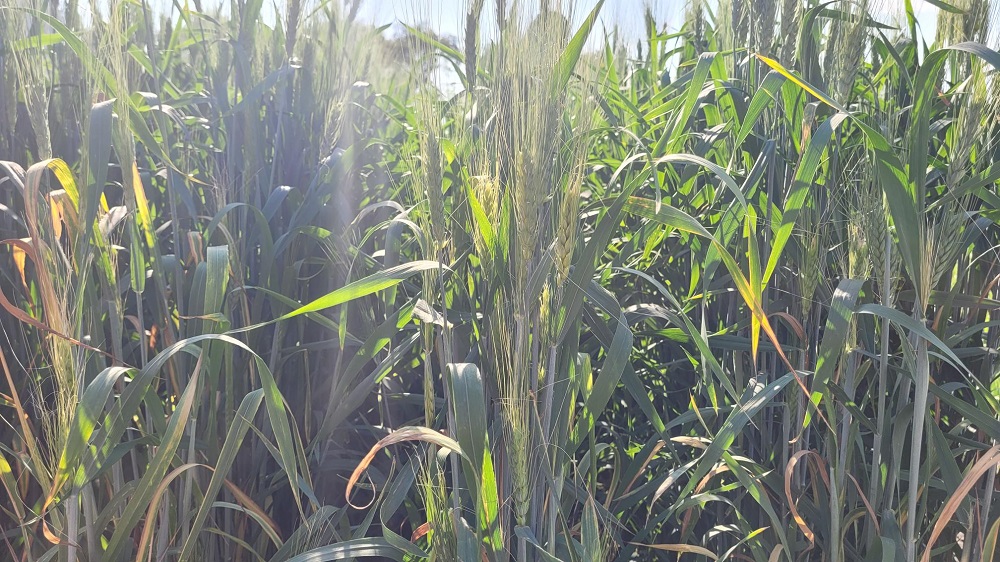Rain was reported in much of the region this week. The Marquis area received 62 mm of rain, the Avonlea area 40 mm, the Grenfell area 24 mm and the Frobisher area 20 mm. This maintained overall good moisture conditions in the region. Cropland is rated as seven per cent surplus, 89 per cent adequate and four per cent short. Hay and pasture land topsoil moisture is rated as two per cent surplus, 89 per cent adequate and nine per cent short.
Ten per cent of the fall cereal crops are in the jointing stage and 26 per cent are in the shot blade stage, while 27 per cent of the spring cereals are tillering. Forty-six per cent of canola and mustard is emerging and 32 per cent is in the seedling stage. Thirty-nine per cent of flax in the seedling stage. Fifty-nine per cent of the pulse crops are emerging and 43 per cent are in the vegetative stage.
Most of the crop damage this week was due to localized heavy rain resulting in flooding, as well as grasshoppers. Producers are busy finishing up seeding, spraying and moving cattle to pasture.
Rain was seen throughout the region this week, which was welcomed by most producers. The Rockglen area received 33 mm this week, the Eyebrow area 32 mm, the Cabri area 25 mm, the Maple Creek area 15 mm, the Leader area eight mm and the Vanguard area five mm.
Precipitation this week helped maintain or improve moisture conditions in parts of the region. Cropland topsoil moisture is rated as one per cent surplus, 79 per cent adequate and 20 per cent short. Hay and pasture land topsoil moisture is rated as 75 per cent adequate, 23 per cent short and two per cent very short.
Thirty-three per cent of the fall cereal crops are in the jointing stage and 23 per cent are heading, while 42 per cent of the spring cereals are tillering. Fifty-nine per cent of canola and mustard is emerging and 40 per cent is in the seedling stage, 39 per cent of flax is also in the seedling stage. Fifty-nine per cent of the pulse crops are emerging and 36 per cent is in the vegetative stage.
The majority of crop damage this week was due to dry conditions, localized flooding and hail, as well as flea beetle and grasshopper damage. Producers have been busy wrapping up seeding, spraying and checking their crops.
Most of the region received rain this week. There are many reports of flooding in the region. Still, many producers were happy to see the rain as it helped improve moisture conditions in the drier parts of the region. The Wynard area received 47 mm of rain, the Saltcoats area 45 mm, the Craven and Stalwart areas 40 mm and the Lipton area 36 mm.
Cropland topsoil moisture is rated as 19 per cent surplus, 71 per cent adequate and 10 per cent short. Hay and pasture land is rated as 19 per cent surplus, 64 per cent adequate, 11 per cent short and six per cent very short.
Recent rain falls and high temperatures have helped support crop emergence and development. Sixteen per cent of the fall cereal crops are in the shot blade stage, while 31 per cent of the spring cereals are tillering. Forty-six per cent of canola and mustard is emerging and 31 per cent is in the seedling stage, along with 10 per cent of flax in the seedling stage. Forty-six per cent of the pulse crops are emerging and 47 per cent are in the vegetative stage.
The majority of crop damage this week was due to localized flooding, wind, flea beetles and grasshoppers. Producers are busy spraying, picking rocks and moving cattle to pasture.
Rain was reported throughout the region this past week. Much of it came in the form of heavy storms. This resulted in some flooding of low spots. The Dinsmore area received 54 mm of rain, the Wilkie area 38 mm, the Rosetown area 22 mm, the Hague area 10 mm and the Kerrobert area two mm.
Moisture conditions have slightly improved in the region. Cropland topsoil moisture is rated as two per cent surplus, 67 per cent adequate, 27 per cent short and four per cent very short. Hay and pasture land topsoil moisture is rated as 55 per cent adequate, 39 per cent short and six per cent very short.
Thirty-eight per cent of the fall cereal crops are in the shot blade stage and 18 per cent are heading, while 47 per cent of the spring cereals are tillering. Thirty-six per cent of canola and mustard is emerging and 54 per cent is in the seedling stage, along with 36 per cent of flax in the seedling stage. Thirty-five per cent of the pulse crops are emerging and 60 per cent is in the vegetative stage.
Crop damage this week was reported due to dry conditions, heat, wind, localized flooding, flea beetles, grasshoppers and gophers. Producers are busy doing in-crop spraying, moving cattle to pasture and picking rocks.
Most areas in the northeast received rain this past week. The Lake Lenore region received 44 mm of rain, the Garrick area 34 mm, the Arborfield area 30 mm and the Star City area 23 mm and the Porcupine Plain area nine mm.
Cropland topsoil moisture is being rated as 11 per cent surplus, 82 per cent adequate and seven per cent short. Hay and pasture land is rated as one per cent surplus, 88 per cent adequate, 10 per cent short and one per cent very short.
Warm weather and adequate moisture have helped crops progress, with many producers stating that crops are ahead in development for this time of year. Thirty-eight per cent of the spring cereals are emerging and 54 per cent are tillering. Thirty per cent of canola and mustard is emerging and 61 per cent is in the seedling stage, while 56 per cent of flax is in the seedling stage. Thirty per cent of the pulse crops are emerging and 68 per cent are in the vegetative stage.
The majority of crop damage this week was due to strong winds, localized flooding, hail, dry conditions, heat and flea beetles. Producers are busy in-crop spraying, although the high temperatures and rain has been delaying some.
Much of the northwest region received rain this past week, but most of it was in the form of spotty rain showers. The Lloydminster area received the highest amount of rain this week with a reported 153 mm. The Meadow Lake area received 39 mm of rain, the Medstead area 38 mm and the Hafford area 14 mm.
Moisture conditions have improved in the region this past week, although more land is being rated as surplus for moisture. Cropland topsoil moisture is rated as three per cent surplus, 79 per cent adequate, 16 per cent short and two per cent very short. Hay and pasture land topsoil moisture is rated as 75 per cent adequate, 19 per cent short and six per cent very short.
Warm weather and recent rainfalls have helped support crop growth. Thirty-seven per cent of the spring cereals are emerging and 53 per cent are tillering. Thirty-four per cent of canola and mustard is emerging and 49 per cent is in the seedling stage, while 53 per cent of flax is in the seedling stage. Thirty-four per cent of the pulse crops are emerging and 52 per cent are in the vegetative stage.
Producers are reporting damage caused by flooding, hail, very dry conditions and flea beetles. Producers in the northwest are continuing in-crop spraying.








